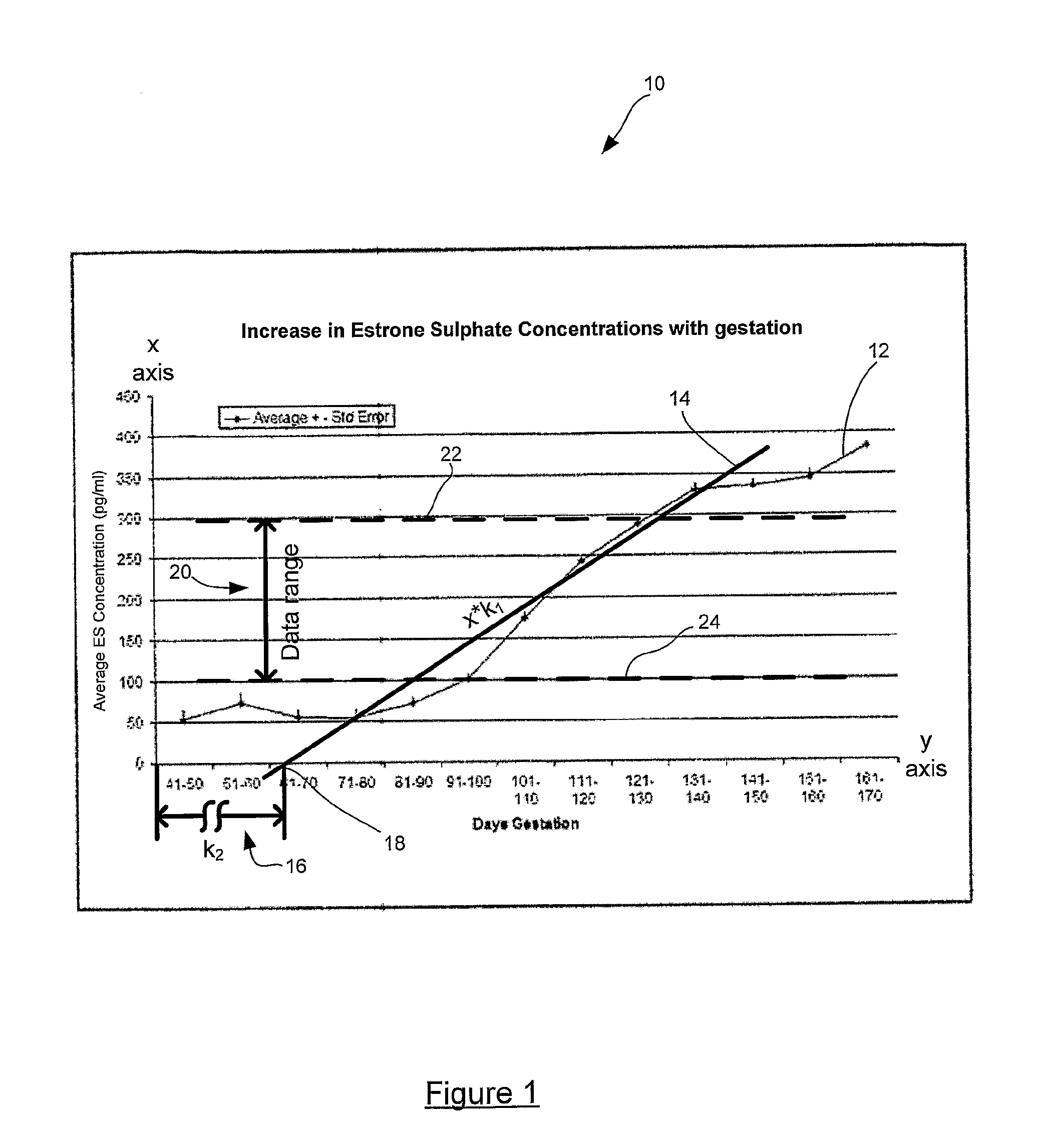Method Related to Gestation Periods
a technology of gestation period and time, applied in the field of gestation period time, can solve the problems of affecting the accuracy of the estimated conception date of the farmer, the risk of spontaneous abortion, disease transmission,
- Summary
- Abstract
- Description
- Claims
- Application Information
AI Technical Summary
Benefits of technology
Problems solved by technology
Method used
Image
Examples
example 1
[0114]A small scale trial of 180 cows was undertaken to assess the sensitivity and specificity and therefore suitability of the ES assay to be utilised in the present invention (Table 1). “Sensitivity” is defined to be the number of cows determined by the test to be pregnant compared to the “gold standard” manual pregnancy diagnosis. “Specificity” is defined to be the number of cows determined by the test to not be pregnant compared to manual pregnancy diagnosis.
TABLE 1Milk ES assayManual Veterinarypregnancy testpregnancy testPregnant104103Not pregnant7677TOTAL180180False Positive*10False Negative00Sensitivity100%100%Specificity99%100%*Assumption - veterinary diagnosis is correct one
[0115]180 cows, all of which would have been more than 120 days pregnant if they were pregnant, had 3 milk samples tested for ES. Of the 103 cows determined to be pregnant by manual pregnancy diagnosis, the ES results also indicated that all 103 cows were pregnant, i.e., 100% sensitivity. Of the 77 not d...
example 2
[0116]A further larger scale trial on 593 cows confirmed the initial findings that an assay to detect a pregnancy specific indicator such as ES is a suitable assay for utilisation in the present invention (Table 2).
TABLE 2Estrone sulphate resultNot confirmedProbablyConfirmedManual ResultpregnantpregnantPregnantTotalNo diagnosis((100-150 pg / ml)(>150 pg / ml)TotalPregnant5931 16* 14{circumflex over ( )}562593Not11518817 9**115DetectablyPregnant2104 31571708Total708*only 8 > 120 days{circumflex over ( )}only 4 > 120 days
[0117]Manual palpitation / ultrasound concluded 593 cows tested were pregnant and 115 cows were not. Of the 593 cows concluded to be pregnant, the ES assay results indicated that 16 were not pregnant; 14 were probably pregnant; and 462 were pregnant. It was not possible to get a result on one sample.
[0118]Of the 115 cows concluded not be pregnant, the ES assay results indicated that 88 were not pregnant; 17 were probably pregnant; and 9 were pregnant. It was not possible t...
example 3
[0121]A further trial was conducted on 200 cows known to not be pregnant or very early pregnant to further assess the specificity of ES testing. That is, to assess whether determining the value of ES from a sample is an accurate means of correctly categorising cows as not pregnant.
[0122]Based on a cut-off level of 150 pg / mL of ES as being indicative of pregnancy, the accuracy of the ES assay in diagnosing non-pregnant cows was 99.5%, being 199 cows out of 200 correctly categorised as not confirmed pregnant (Table 3).
TABLE 3Levels of ES (pg / mL)No. of cows 0-2013621-6037 61-10023101-1402141-1501 (150 pg / ml)Over 1500TOTAL199
PUM
 Login to View More
Login to View More Abstract
Description
Claims
Application Information
 Login to View More
Login to View More - R&D
- Intellectual Property
- Life Sciences
- Materials
- Tech Scout
- Unparalleled Data Quality
- Higher Quality Content
- 60% Fewer Hallucinations
Browse by: Latest US Patents, China's latest patents, Technical Efficacy Thesaurus, Application Domain, Technology Topic, Popular Technical Reports.
© 2025 PatSnap. All rights reserved.Legal|Privacy policy|Modern Slavery Act Transparency Statement|Sitemap|About US| Contact US: help@patsnap.com



